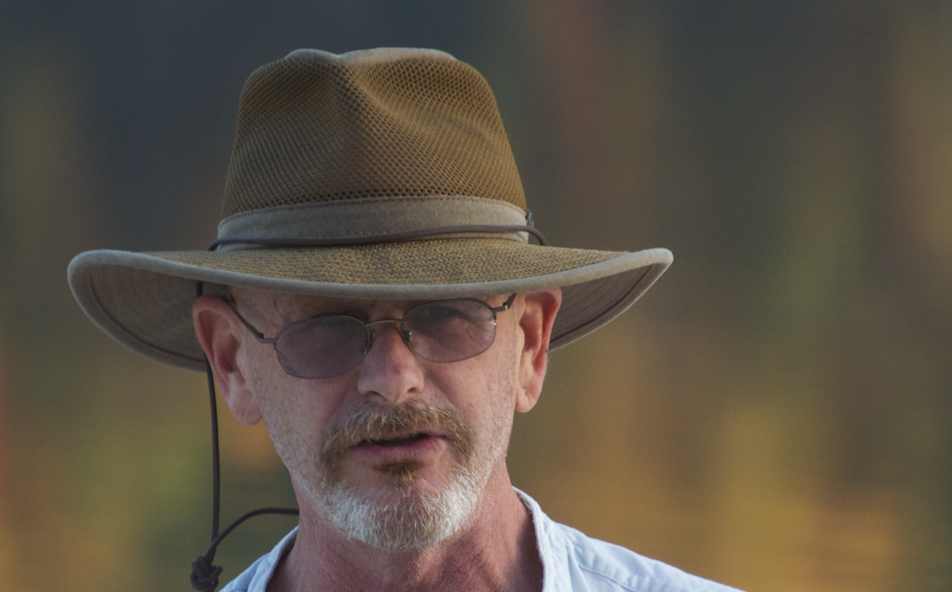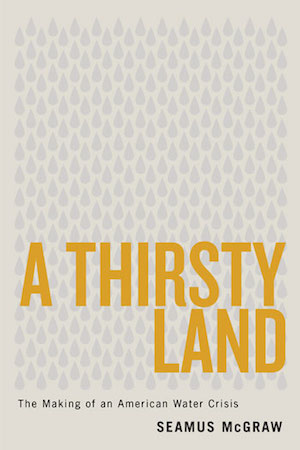
Seamus McGraw
Texans don’t like to think of themselves as a small version of anything, but journalist Seamus McGraw argues that in fact when it comes to water problems the Lone Star State can be seen as a microcosm for challenges facing the country as a whole.
He makes a deep dive into Texas water issues in his new book “A Thirsty Land: The Making of an American Water Crisis” (University of Texas Press, $27.95), drawing on his travels through the state talking to farmers and ranchers, local officials, policy experts and others to tell the story “from the human perspective.”
A New Jersey native raised in rural northeastern Pennsylvania, where he still lives with his wife and children, McGraw is also the author of “The End of Country: Dispatches From the Frack Zone,” about his own and his neighbors’ struggles deciding whether to lease their land to drillers, and “Betting the Farm on a Drought: Stories From the Front Lines of Climate Change.”
He discussed his new book with TCN senior editor Fritz Lanham. The interview has been edited for clarity and length.
+++
Early in your book you ask, “How do you manage a resource that everybody needs when everybody thinks their needs are paramount?” That seems a formula for perpetual conflict and at best imperfect solutions.
Absolutely. That is cast in stark relief in Texas. But that question is facing every place in the country. I’ve spoken about this book from Alpine, Texas, to Block Island, Rhode Island. Block Island gets its water from a bubble of fresh water trapped atop salt water below the island. The slightest bit of additional drilling or the failure to compensate for rising sea wipes that out and the place becomes uninhabitable. Yet you have, as you have everywhere, people saying, “Yeah, but I need.” And that complicates any response.
Back in 1969 a geographer named D.W. Meinig wrote a book called Imperial Texas in which he argued that as much as Texas likes to think of itself as a republic, it’s an empire, a series of geographically distinct places, peopled by diverse and different groups, held together by the idea of the mythic Texan – fiercely independent, somewhat rural in nature, smells a little like leather and gun oil, committed to making an individual way in a harsh and unforgiving environment. At the same time – and this is something that’s kind of been lost from the myth in recent years – there’s the sense of that individual being a member of a community.
The biggest problem facing Texas right now, and the biggest problem facing America right now, is the idea that has taken root over the last 40 years that that swaggering individualism outweighs that sense of the individual as part of a community. The best way to put it is the way [San Antonio State Rep.] Lyle Larson does: At this point either we’re all Texans or we aren’t.
A lot of people may not understand the bifurcated system we have in this state in which groundwater rights are governed by one set of rules and surface water by a different set. Start by explaining the “rule of capture.”
The simplest way to put the rule of capture is whoever has the biggest pump wins. It grows out of a [Texas Supreme Court] decision 115 years ago in which the railroad in the Fort Worth area stuck a well in the ground and sucked up all the water from underneath a neighbor guy named East. When East’s water went south, he sued. And lost.
 The Texas Supreme Court ruled that groundwater was – and these are their exact words – “mysterious and occult,” and because it was so inscrutable they decided to apply ancient British common law and said if you pump it, it’s yours. If I stick a well in my land and it sucks up all the water from under your land, your recourse is to get a bigger pump and pump more before I do.
The Texas Supreme Court ruled that groundwater was – and these are their exact words – “mysterious and occult,” and because it was so inscrutable they decided to apply ancient British common law and said if you pump it, it’s yours. If I stick a well in my land and it sucks up all the water from under your land, your recourse is to get a bigger pump and pump more before I do.
To be fair, Texas has over the years created groundwater districts with the ability to regulate to some degree how water is taken. But it’s very limited regulation.
With surface water the rule is “first in time, first in right.” How does that work?
This is based on old Spanish law. The idea is you have x amount of surface water – a small amount of water – for household use that is guaranteed. Beyond that, for agricultural purposes and whatnot, rights are recorded, and the earlier your rights are, the more protected they are in times of drought. So in a situation where you’re facing a decline in river flows, the first people who get cut off are the last ones to acquire those rights.
This becomes even more of a problem because in many cases your aquifers and your surface water are interconnected. So in times of drought those aquifers are getting drawn down more quickly and recharging less quickly. You start to see certain people and certain groups being cut off earlier and earlier, and you end up with battles between rural interests and urban interests, industrial interests and urban interests, and industrial interests and agricultural interests.
This creates another obstacle. You have areas in Texas that have 12 inches of rain year, and you have areas that get 65 inches of rain a year. One would think the easiest solution would be to ship the water from the wet place to the dry place, particularly when you’re talking about surface water.
Problem with that is once you move water out of its basin, the rights in the hierarchy lose their standing; they become junior water rights. So that’s another issue that needs to be addressed going forward.
Part of the problem, you write, is that for decades state government leaders have punted on water issues and let the courts try to resolve these conflicts. The courts have been increasingly deferential to the rule of capture, probably reflecting a more doctrinaire conservative judiciary. But the courts don’t really want to be the ones who figure all this out.
As you read the rulings you hear increasing frustration among the justices [telling state officials], “You know, guys, this is your job, not ours.”
Do you see evidence of that changing?
Maybe I’m just a pie-eyed optimist, but I do see it changing.
You are talking in many cases about moving water from one place to another. What’s the legal status of that water when you take water that doesn’t belong in an aquifer and put it in an aquifer? What does that suggest in terms of the rule of capture and those sorts of things?
We’re opening up a can of worms because we have to. Partisanship is always an issue, and ideology is always an issue, but there comes a time when the circumstances become so dire and the problem so obvious that people rise to the challenge, and I think you’re starting to hear that in different voices.
To be specific you’re suggesting that state will have to adopt a much more top-down, statewide approach to managing water issues.
That is certainly my view. There is a way of doing it without diminishing necessarily the authority – and certainly not the input – of the regional and local authorities. These individual groundwater districts or the 16 regional water districts – nobody knows [the situation] better than those people. But there needs to be an enhanced level of authority above that.
Finally, it’s safe to say that climate change will exacerbate water problems?
Not only that but it complicates some of the solutions. If you talk to [the Texas Water Development Board’s deputy executive administrator] Bob Mace, for example, he’ll tell you that the thing that lets him sleep at night is the Gulf of Mexico, that ultimately we’ll be able to come up with technological response that allows us to do saltwater desalinization.
It’s done elsewhere, no question about it. The problem is, where are you going to build these plants to suck up and treat the water? You’re going to build them in the places that are the most vulnerable to those terrible storms that are getting worse.
+++++
Fritz Lanham is a senior editor of Texas Climate News. An independent journalist in Houston, he was books editor at the Houston Chronicle for 16 years.
Image credit: University of Texas Press
